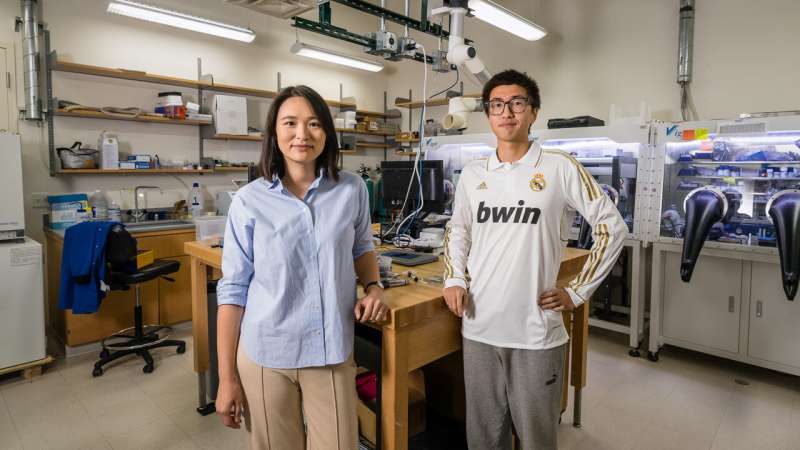Enabling an electric future, engineers create electrode-agnostic electrolyte
In developing a versatile new electrolyte, a team of University of Wisconsin–Madison engineers has taken the next step toward a more efficient, energy-dense battery that could supplant today’s ubiquitous lithium-ion batteries. This new battery type—an initially anode-free sodium-ion battery—is a leading candidate for powering future electric vehicles or storing energy in the electrical grid.
The team also is using the new electrolyte as a model system to understand how to manipulate molecules in the electrolyte so that the medium is compatible with dissimilar battery components.
Led by Fang Liu, a UW–Madison assistant professor of materials science and engineering, and Ph.D. students Qianli Xing and Ziqi Yang, the research team published details of its advance in Nature Communications.
Typically, batteries are made up of two electrodes—an anode (negative side) and a cathode (positive side)—as well as a liquid electrolyte. In this case, the “initially anode-free” aspect of the battery means its physical anode forms internally upon the battery’s first charge—making it simpler, less expensive and more energy-dense.
Containing solvents and dissolved salts, the electrolyte is the liquid medium that touches all parts of the battery’s cells and, in its charging or discharging process, helps ions travel between the electrodes.
In a battery, the anode and cathode are different materials—for example, graphite, hard carbon sodium or lithium for the anode and a transition metal oxide like lithium nickel manganese cobalt oxide or sodium nickel iron manganese oxide for the cathode.
One of the challenges in developing next-generation batteries is that there’s not a one-size-fits-all electrolyte that performs effectively with both electrode material types. Conversely, when an electrolyte contains multiple solvent molecules, controlling their interactions and behavior is challenging.
Tweaking the electrolyte is a balancing act involving multiple factors, including how solvent molecules in the electrolyte form a “shell” around ions that could accelerate or impede the ions’ movement between anode and cathode—which ultimately affects battery charging and discharging, along with overall battery performance.
“Using this model system, we are basically trying to understand whether we can present different molecules to different electrode surfaces—for example, an anode-stable solvent to the anode, and then a cathode-stable solvent to the cathode,” says Liu.
“In this way, the electrolyte mixture would ideally behave like an anode-stable solvent at the anode, and like a cathode-stable solvent at the cathode.”

To create its new electrolyte, the team mixed two ether-based solvents, 2-methyltetrahydrofuran, or 2-MeTHF, which is more stable at the anode, and tetrahydrofuran, or THF, which is more stable at the cathode.
Importantly, they found a way to rationalize electrolyte design: Solvents that dominate the first shell around positively charged ions that travel between electrodes are key to anode stability, while “free” or more weakly bonded solvents are important to the stability of the cathode side.
“Through this electrolyte engineering work, we were trying to demystify what determines the stability of the anode and cathode separately, and how to present suitable molecules to both electrodes,” says Liu.
“Qianli found out that the key factor is the population of solvents in the first solvation shell versus outside, and their location determines their presentation during the battery formation process.”
Computational testing, conducted by collaborator Reid Van Lehn, an associate professor of chemical and biological engineering at UW–Madison, and his student Jung Min Lee, played a significant role in the research as well. They used all-atom molecular dynamics simulations to predict the composition of solvent molecules near sodium ions and determine whether those ions “preferred” one solvent over the other.
“Our results indeed found—in good agreement with experiments from the Liu group—that we could identify a single strongly interacting solvent (2-MeTHF) and a weakly interacting solvent (THF),” says Van Lehn.
“We further used these calculations to relate this behavior to the relative strength of interactions of each type of solvent, providing molecular-scale insight that can be extended to even more complex mixtures to continue optimizing electrolyte design.”
The research lays the groundwork for the next steps in developing not simply sodium-metal batteries, but also other new alternatives to lithium-ion batteries.
“Through this research, we start to understand that the solvent and anion interactions become really important,” says Liu. “We’re trying to expand our solvent library to manipulate these kinds of interactions, to see whether this kind of working principle can be applied to broader solvent libraries and different battery chemistries.”
More information:
Qianli Xing et al, Directing selective solvent presentations at electrochemical interfaces to enable initially anode-free sodium metal batteries, Nature Communications (2025). DOI: 10.1038/s41467-025-63902-4
University of Wisconsin-Madison
Citation:
Enabling an electric future, engineers create electrode-agnostic electrolyte (2025, September 22)
retrieved 22 September 2025
from https://techxplore.com/news/2025-09-enabling-electric-future-electrode-agnostic.html
This document is subject to copyright. Apart from any fair dealing for the purpose of private study or research, no
part may be reproduced without the written permission. The content is provided for information purposes only.

Comments are closed